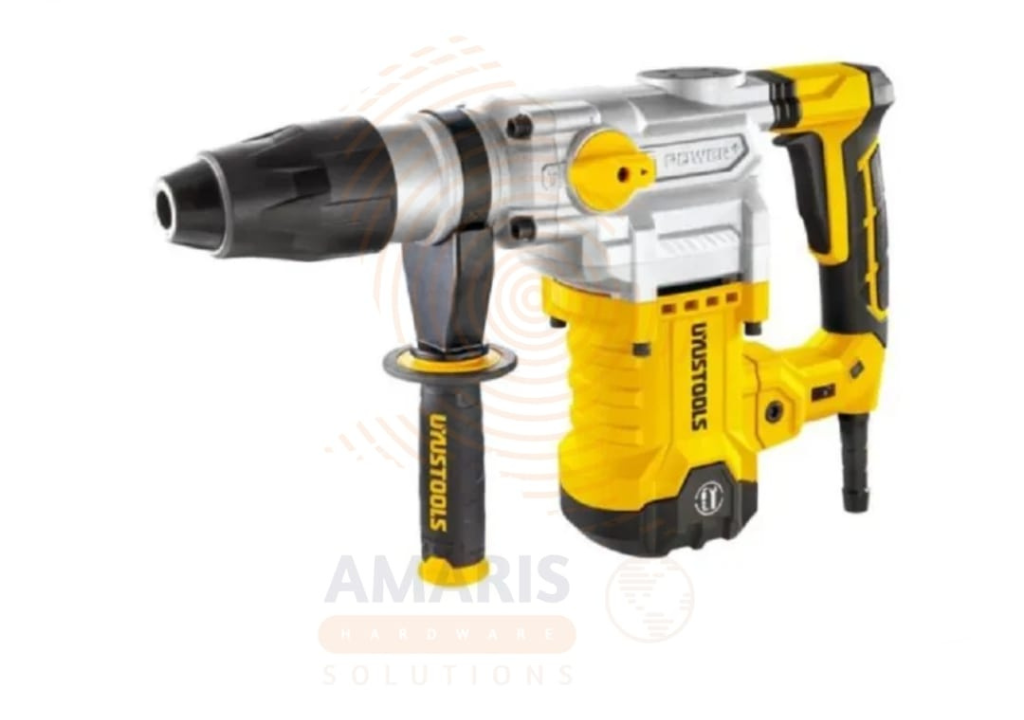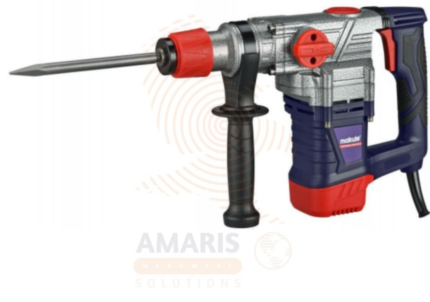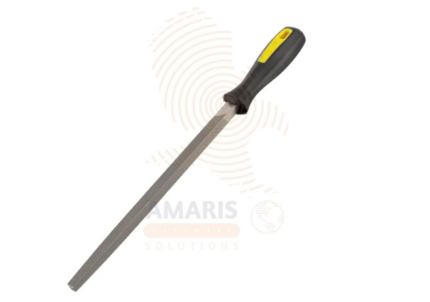Rotary Hammer Variable Speed
WhatsApp Order
A Rotary Hammer Variable Speed refers to a power tool designed for drilling into tough materials like concrete, masonry, or stone. The term “variable speed” indicates that the tool allows the user to control the speed of the rotary motion, providing flexibility to match the drilling application and material hardness. The “1600 watts” specification denotes the power of the tool’s motor, indicating its capability to deliver a higher level of energy for efficient drilling through challenging surfaces. Overall, a rotary hammer with these specifications is a robust and versatile tool suitable for demanding construction and renovation tasks.
Description
Table of Contents
ToggleRotary Hammer Variable Speed
Uses
-
Concrete Drilling: Rotary hammers are well-suited for drilling into concrete and masonry. The high wattage ensures efficient drilling even in tough materials, making it a preferred tool for tasks like installing anchors or creating holes for electrical and plumbing work.
-
Demolition Work: The rotary hammer’s impact mechanism allows it to excel in demolition tasks. It can break up and remove concrete or masonry surfaces, making it useful for remodeling projects where old structures need to be demolished.
-
Chiseling: With the right attachments, rotary hammers can be used for chiseling tasks. This is handy for tasks such as tile removal or shaping stone or brick surfaces.
-
Heavy-duty Drilling: The high wattage of a 1600-watt rotary hammer makes it suitable for heavy-duty drilling tasks in various materials, providing more power and efficiency compared to standard drills.
-
Construction and Renovation Projects: Whether it’s installing electrical boxes, plumbing pipes, or creating holes for anchor bolts, the rotary hammer is a versatile tool for a range of construction and renovation projects.
-
Professional Use: Due to its power and versatility, a rotary hammer of this caliber is often favored by professionals in the construction and contracting industry for its ability to handle demanding applications efficiently.
-
Landscaping: In landscaping projects, rotary hammers can be used for tasks such as drilling holes for fence posts or anchors in retaining walls.
-
Tunneling and Excavation: In certain situations, rotary hammers may be used for tunneling or excavation work, especially in softer rock or soil conditions.
SAFETY HANDLING PRECAUTIONS
Safety Precautions
-
Wear Personal Protective Equipment (PPE)
-
Safety glasses to protect eyes from flying debris and dust
-
Hearing protection to guard against high noise levels
-
Dust mask or respirator to prevent inhalation of harmful dust
-
Gloves to reduce hand fatigue and improve grip
-
Safety boots to protect feet from falling objects
-
Helmet for protection in overhead work or construction sites
-
-
Inspect the Tool Before Use
-
Check for cracks, wear, or loose parts
-
Ensure power cords or batteries are undamaged and securely connected
-
Make sure the bit is the correct type and properly locked in place
-
-
Use the Correct Bit
-
Match the bit to the material (e.g., SDS-Plus or SDS-Max for concrete)
-
Do not use worn or damaged bits
-
-
Secure the Work Area
-
Clear the area of non-essential personnel and obstructions
-
Ensure stable footing and adequate lighting
-
Check for electrical wires or plumbing in walls before drilling
-
-
Maintain Proper Grip and Stance
-
Use both hands on the tool for control
-
Keep a balanced and stable body position
-
Avoid overreaching while drilling
-
-
Start at Low Speed
-
Align the bit first, then gradually increase speed
-
Avoid sudden contact that could cause kickback
-
-
Use Dust Control Methods
-
Use integrated or external dust collection systems if available
-
Avoid prolonged exposure to airborne dust
-
-
Prevent Overheating
-
Allow the tool to rest periodically during long tasks
-
Keep air vents clear of dust and debris
-
-
Disconnect When Not in Use
-
Unplug corded tools or remove batteries before changing bits or maintenance
-
Do not carry the tool while plugged in or powered on
-
-
Store Safely After Use
-
-
Clean the tool and store in a dry, secure location
-
Keep out of reach of children
-
Regularly check and maintain accessories
-
Related products
ACCESSORIES FOR DIE POLISHER SET
Accessories for Die Polisher Set typically refers to a collection of ten individual components designed for use with a die polisher, with each accessory having a diameter of 6mm. These accessories are likely to be various tools or attachments intended for polishing or refining surfaces in die-cutting applications.
Bi-Metal Hole Saw Set
A 9 PCS Bi-Metal Hole Saw Set refers to a collection of nine hole saws, each constructed with a bi-metal design. A hole saw is a cylindrical cutting tool used to create holes in various materials such as wood, metal, plastic, and more. The term "bi-metal" indicates that the hole saws are made from two different types of metals, typically high-speed steel (HSS) and a more durable alloy like cobalt. This combination enhances the hole saw's cutting performance, making it suitable for a wide range of applications and providing increased durability and longevity. The set typically includes hole saws of different sizes to accommodate various hole diameters, making it a versatile tool for professionals and DIY enthusiasts alike.
Cement Blender
A cement blender is a mechanical device designed for the purpose of mixing and blending various components of cementitious materials, such as cement, sand, and water, to create a homogenous mixture. This blended mixture is commonly used in construction and building projects, particularly for applications like concrete production. The blender typically features a rotating drum or container that facilitates the thorough mixing of the ingredients, ensuring a consistent and uniform composition for the construction materials.
Cement Blender – SDS Plus
A cement blender with an SDS-PLUS mechanism typically refers to a power tool designed for mixing cement, mortar, or other construction materials. The term "SDS-PLUS" refers to a specific chuck and bit system commonly used in rotary hammers and drills. SDS-PLUS chucks allow for quick and secure attachment of drill bits and other accessories.
In the context of a cement blender with SDS-PLUS, it likely means that the tool has a specialized chuck system for easy attachment of mixing paddles or blades used in blending cement or similar materials. The SDS-PLUS system is known for its quick-change capability, enhancing efficiency and convenience when working with different attachments. The blender's design may include features to ensure effective mixing of construction materials, making it suitable for tasks like preparing mortar or concrete on construction sites.
Double – End Bits Set
PRODUCT DESCRIPTION
A Double-End Bits Set typically refers to a collection of interchangeable tool bits designed for use with screwdrivers, power drills, or similar tools. Each bit in the set has two distinct ends with different types or sizes of tips, allowing the user to perform various tasks without needing multiple individual bits. These sets often include a variety of common bit types, such as Phillips, slotted, Torx, or hex, providing versatility for different screw and fastener types. The double-ended design allows users to flip the bit and switch between different tips easily, making it a convenient and space-saving solution for various applications.
Electric Spray Gun
PRODUCT DESCRIPTION
An electric spray gun is a handheld device powered by electricity that utilizes a motor-driven pump or turbine to atomize liquid coatings, such as paint or varnish, into a fine mist. This fine spray is then evenly and efficiently applied to surfaces, providing a smooth and uniform finish. Electric spray guns are commonly used in various industries and DIY applications for tasks such as painting walls, furniture, automotive components, and other surfaces requiring a professional and even coating. The electric power source distinguishes them from other types of spray guns that may be powered by compressed air or other means.
Fibre Strengthened Resin Cutting Wheel
PRODUCT DESCRIPTION
A fiber-strengthened resin cutting wheel refers to a cutting tool designed for various machining applications, particularly in the context of metalworking or construction. This type of cutting wheel is composed of a resin matrix, which serves as a binding material, reinforced with fibers for added strength and durability. The fibers are typically made of materials such as fiberglass or other composite materials.
The combination of resin and fibers enhances the cutting wheel's structural integrity, making it more resistant to breakage and providing improved performance during cutting operations. The reinforced design allows the wheel to withstand higher levels of mechanical stress and heat generated during cutting processes. Fiber-strengthened resin cutting wheels are commonly used in applications like cutting metal, steel, or other hard materials, where precision and durability are crucial.
Flat Knotted Wire Wheel
PRODUCT DESCRIPTION
A knotted wire wheel refers to a rotating tool used in various applications, typically in metalworking and surface preparation. It consists of a wheel-shaped assembly with wire bristles that are tightly twisted or "knotted" together. The wire bristles can be made of steel or other durable materials, and they are arranged in a radial pattern around the wheel.
Knotted wire wheels are commonly attached to power tools such as angle grinders or bench grinders. They are employed for tasks like removing rust, paint, scale, or other surface contaminants from metal surfaces, as well as for deburring or blending welds. The tightly twisted configuration of the wire bristles enhances the wheel's durability and effectiveness in tackling tough materials and applications.
These wheels are available in various sizes and designs to suit different tasks, and they are known for their abrasive action, making them valuable tools in metal fabrication, construction, and maintenance work.


 Acrylic Sealants
Acrylic Sealants Construction Adhesives
Construction Adhesives Double-Sided Tape
Double-Sided Tape Duct Tape
Duct Tape Electrical Tape
Electrical Tape Epoxy & Resins
Epoxy & Resins Masking Tape
Masking Tape
 Automotive Wrenches & Socket Sets
Automotive Wrenches & Socket Sets Battery Chargers & Jump Starters
Battery Chargers & Jump Starters Car Jacks & Stands
Car Jacks & Stands Car Wash & Detailing Products
Car Wash & Detailing Products Diagnostic Tools
Diagnostic Tools Tire Inflators
Tire Inflators Vehicle Lighting
Vehicle Lighting Oil & Lubricants
Oil & Lubricants
 Adhesives & Sealants
Adhesives & Sealants Bricks & Blocks
Bricks & Blocks Cement & Concrete
Cement & Concrete Drywall & Plaster
Drywall & Plaster Flooring (Tiles, Wood, Laminate)
Flooring (Tiles, Wood, Laminate) Lumber & Plywood
Lumber & Plywood Paints, Primers & Coatings
Paints, Primers & Coatings Insulation Materials
Insulation Materials Roofing Materials
Roofing Materials
 Circuit Breakers
Circuit Breakers Electrical Cables & Wires
Electrical Cables & Wires Switches & Sockets
Switches & Sockets Fuses & Relays
Fuses & Relays Connectors & Terminals
Connectors & Terminals Electrical Boxes & Panels
Electrical Boxes & Panels Conduit & Fittings
Conduit & Fittings Lighting Fixtures & Bulbs
Lighting Fixtures & Bulbs Extension Cords & Power Strips
Extension Cords & Power Strips
 Anchors
Anchors Bolts
Bolts Clips & Clamps
Clips & Clamps Screws
Screws Nuts
Nuts Washers
Washers Rivets
Rivets Nails
Nails Threaded Rods
Threaded Rods
 Hammers
Hammers Measuring Tools (Tapes, Levels, Calipers)
Measuring Tools (Tapes, Levels, Calipers) Screwdrivers
Screwdrivers Pliers & Cutters
Pliers & Cutters Saws & Blades
Saws & Blades Chisels & Punches
Chisels & Punches Allen Keys & Hex Keys
Allen Keys & Hex Keys Ratchets & Socket Sets
Ratchets & Socket Sets Wrenches & Spanners
Wrenches & Spanners
 Power Tool Accessories (Blades, Bits, Discs)
Power Tool Accessories (Blades, Bits, Discs) Rotary Tools
Rotary Tools Saws (Circular, Jigsaw, Reciprocating)
Saws (Circular, Jigsaw, Reciprocating) Drills & Drivers
Drills & Drivers Grinders & Sanders
Grinders & Sanders Heat Guns
Heat Guns Nail Guns
Nail Guns Impact Wrenches
Impact Wrenches Batteries & Chargers
Batteries & Chargers
 Pipes & Fittings (PVC, Copper, PEX)
Pipes & Fittings (PVC, Copper, PEX) Plumbing Tools
Plumbing Tools Pumps & Motors
Pumps & Motors Sealants & Adhesives for Plumbing
Sealants & Adhesives for Plumbing Valves & Taps
Valves & Taps Water Heaters
Water Heaters Drainage Systems
Drainage Systems Faucets & Fixtures
Faucets & Fixtures Hoses & Tubing
Hoses & Tubing
 Hinges & Latches
Hinges & Latches Hooks & Brackets
Hooks & Brackets Window Hardware
Window Hardware Chains & Cables
Chains & Cables Casters & Wheels
Casters & Wheels Shelving & Storage Systems
Shelving & Storage Systems Door Handles & Locks
Door Handles & Locks Drawer Slides & Cabinet Hardware
Drawer Slides & Cabinet Hardware
 Personal Protective Equipment (PPE)
Personal Protective Equipment (PPE) Respirators & Masks
Respirators & Masks Safety Glasses
Safety Glasses Safes
Safes Security Cameras
Security Cameras Gloves
Gloves Helmets
Helmets Ear Protection
Ear Protection Fire Safety Equipment
Fire Safety Equipment Locks & Padlocks
Locks & Padlocks Motion Sensors & Alarms
Motion Sensors & Alarms
 Garden Fencing
Garden Fencing Garden Furniture Hardware
Garden Furniture Hardware Lawn Mowers
Lawn Mowers Trimmers & Edgers
Trimmers & Edgers Shovels & Spades
Shovels & Spades Rakes & Hoes
Rakes & Hoes Pruning Shears & Loppers
Pruning Shears & Loppers Watering Systems (Hoses, Sprinklers, Nozzles)
Watering Systems (Hoses, Sprinklers, Nozzles)
 Interior Paints
Interior Paints Paint Brushes & Rollers
Paint Brushes & Rollers Paint Strippers & Thinners
Paint Strippers & Thinners Paint Trays & Accessories
Paint Trays & Accessories Exterior Paints
Exterior Paints Spray Paints
Spray Paints Primers & Undercoats
Primers & Undercoats Varnishes & Stains
Varnishes & Stains
 Gaskets & Seals
Gaskets & Seals Hydraulic Fittings
Hydraulic Fittings Industrial Fasteners
Industrial Fasteners Industrial Hoses
Industrial Hoses Lubricants & Greases
Lubricants & Greases Metal Sheets & Bars
Metal Sheets & Bars Bearings & Bushings
Bearings & Bushings Belts & Pulleys
Belts & Pulleys
 HVAC Filters
HVAC Filters Insulation for HVAC
Insulation for HVAC Air Conditioners
Air Conditioners Refrigerants
Refrigerants Ventilation Ducts & Fittings
Ventilation Ducts & Fittings Thermostats & Controllers
Thermostats & Controllers Fans & Blowers
Fans & Blowers
 Pegboards & Hooks
Pegboards & Hooks Shelving Units
Shelving Units Storage Bins & Containers
Storage Bins & Containers Toolboxes & Tool Chests
Toolboxes & Tool Chests Workbenches
Workbenches Drawer Organizers
Drawer Organizers Labeling Supplies
Labeling Supplies
 Welding Accessories (Clamps, Brushes)
Welding Accessories (Clamps, Brushes) Welding Electrodes & Rods
Welding Electrodes & Rods Welding Helmets & Gloves
Welding Helmets & Gloves Welding Machines
Welding Machines Soldering Irons & Stations
Soldering Irons & Stations Flux & Solder Wire
Flux & Solder Wire
 Generator Accessories
Generator Accessories Inverters
Inverters Portable Generators
Portable Generators Power Inverters
Power Inverters Transfer Switches
Transfer Switches Diesel & Gasoline Generators
Diesel & Gasoline Generators
 Transport Equipment: Carts, Dollies, and Hand Trucks
Transport Equipment: Carts, Dollies, and Hand Trucks Storage Solutions: Pallets, Racks, and Containers
Storage Solutions: Pallets, Racks, and Containers Lifting Equipment: Hoists, Cranes, and Jacks
Lifting Equipment: Hoists, Cranes, and Jacks Conveyors and Accessories: Belts and Rollers
Conveyors and Accessories: Belts and Rollers






